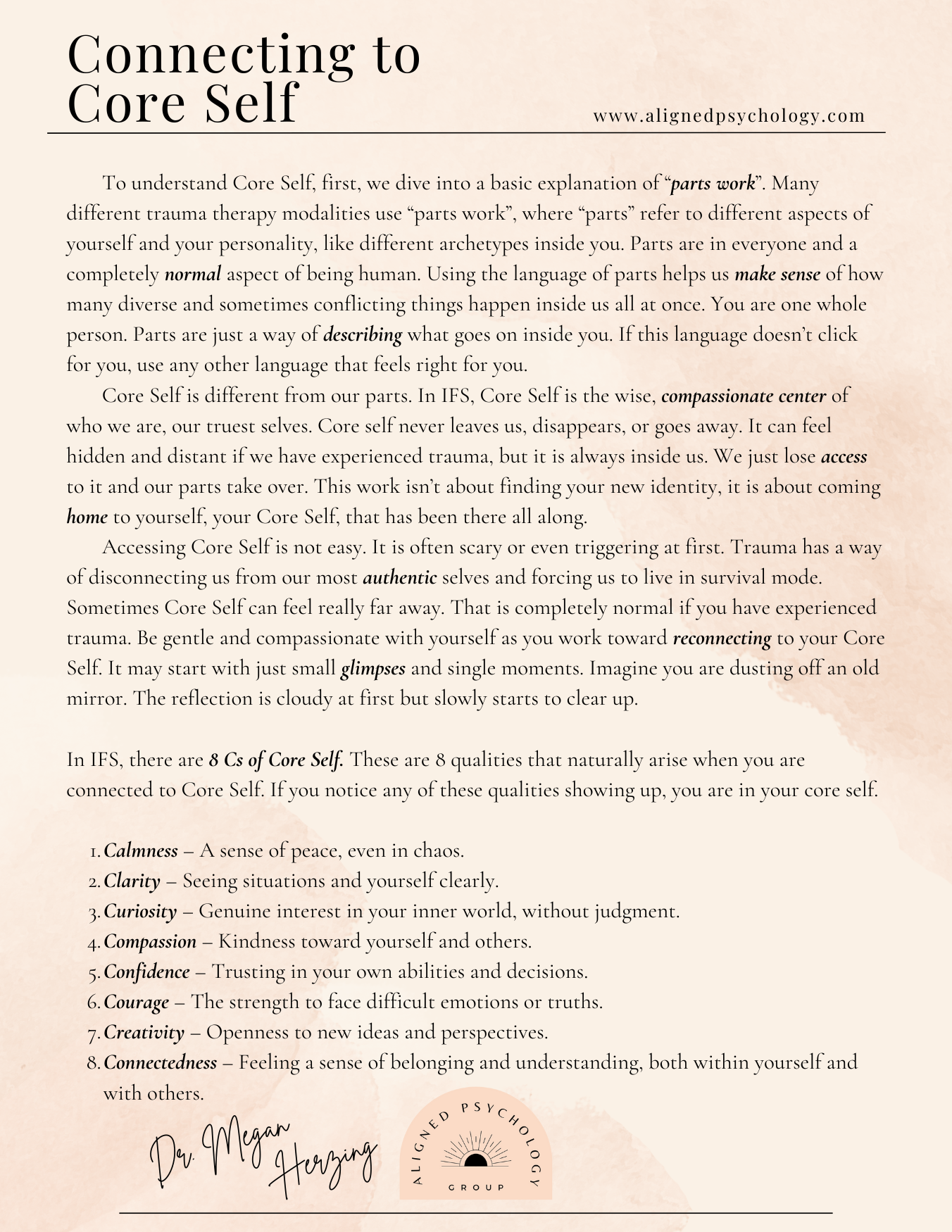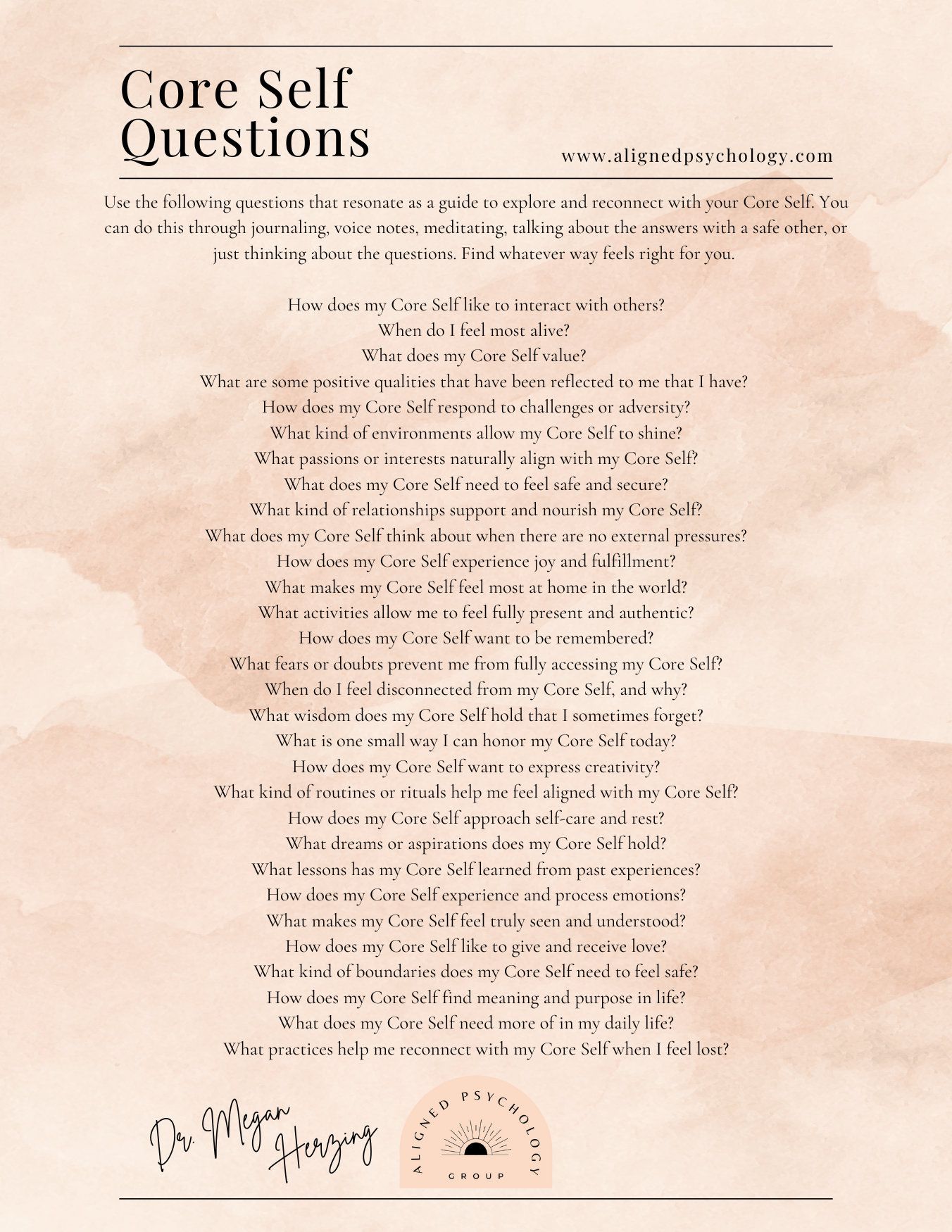Trauma Therapy Homework - Week 14
Week 14: (The Basics)
Connecting to Core Self
If you’ve made it to Week 14 of your trauma therapy journey, that’s a big deal—seriously, give yourself a moment of acknowledgment. Doing this work takes real courage. This week, we’re diving into something incredibly powerful: connecting to your Core Self. When exploring Core Self, it’s helpful to start with the basics of what is called "parts work". Many trauma therapy approaches use 'parts work,' where 'parts' simply refer to different aspects of your personality—like inner archetypes. This is a completely normal part of being human, and everyone has different parts of themselves. Think of it like saying, 'A part of me is excited about this new job, but another part feels nervous and scared.' Using parts in our language and self-concept helps us make sense of the many, sometimes conflicting, thoughts and feelings we experience at once. But here’s the important thing—you are one whole person. These parts are just ways to understand the beautiful complexity within you. And if the idea of 'parts' doesn’t quite click for you, that’s okay! You can still work on connecting with your Core Self without using that specific language. Feel free to use any term that feels more natural or meaningful to you. The goal is simply to deepen your understanding of yourself in a way that feels right for you.
What is the Core Self?
The idea of the Core Self is in many different trauma therapy modalities. This post will explore ideas about the Core Self from Internal Family Systems (IFS) therapy, and it’s all about the belief that each of us has a wise, compassionate core. Think of it as your truest, most authentic self. The amazing thing? No matter what you’ve been through, your Core Self never disappears. It can feel hidden or distant, especially if you’ve been living more from protective or wounded parts of yourself, but it’s always there, waiting for you to reconnect. Life happens. Trauma happens. And sometimes, in trying to cope, we lose touch with that steady, grounded part of ourselves. But here’s the truth: The core Self doesn’t vanish; we just lose access to it through trauma. The work isn’t about creating a new “you”—it’s about coming home to what’s been there all along.

Why Accessing Core Self Can Feel Hard
Now, let’s be real—getting in touch with your Core Self isn’t always easy. It can feel scary or triggering at first. Trauma has a way of pulling us into survival mode, making us live from parts of ourselves designed to protect us—like the perfectionist, the critic, or the avoider.
Sometimes, the Core Self can feel really far away. Maybe you catch tiny glimpses of it—a moment of calm, a deep sense of knowing—but it slips away just as fast. That’s normal. It’s like dusting off an old mirror; at first, the reflection is cloudy, but with time and care, it clears up. The journey back to the Core Self starts with curiosity, patience, and, most importantly, looking inward.
The 8 C’s of the Core Self
According to IFS, there are eight qualities that naturally arise when you’re connected to your Core Self. These are often called the “8 C’s”:
- Calmness – A sense of peace, even in chaos.
- Clarity – Seeing situations and yourself clearly.
- Curiosity – Genuine interest in your inner world, without judgment.
- Compassion – Kindness toward yourself and others.
- Confidence – Trusting in your own abilities and decisions.
- Courage – The strength to face difficult emotions or truths.
- Creativity – Openness to new ideas and perspectives.
- Connectedness – Feeling a sense of belonging and understanding, both within yourself and with others.
If you notice even one of these qualities showing up—perhaps in small ways—you’re tapping into your Core Self.
The Power of Self-Reflection
To connect with your Core Self, self-reflection is key. Think of it as a tool that helps you navigate your inner world. Self-reflection is about pausing long enough to ask, “What’s really going on inside me?” It is the ability to notice your thoughts, emotions, sensations, and reactions.
Developing self-reflection takes practice. Start small:
- Journaling: Spend a few minutes each day writing about how you feel. No filters, no judgment—just raw, honest thoughts. You can also voice journal if you don't like writing. You can even imagine you are journaling in your head if you don't like either of those ideas.
- Body Scans: Close your eyes and scan your body from head to toe. Where do you feel tension? Where do you feel ease? Where do you feel emotion? Your body often holds wisdom your mind overlooks.
- Mindful Moments: Throughout your day, pause and ask, “What am I feeling right now? What can I notice about myself in this moment? What is happening inside me?”
The more you tune in, the more familiar your internal landscape becomes. Over time, you’ll start to notice when you’re acting from a more wounded or protective part of yourself or from your Core Self.

Learning Your Preferences: What Do You Like?
One simple but powerful way to strengthen your connection to the Core Self is by tuning into your preferences. Trauma often makes us disconnect from what we like or dislike, leaving us focused on survival rather than personal expression. Sometimes, we learn to conform ourselves to what other people like and dislike, to keep ourselves safe or connected. Sometimes, we even need to conform to what others want us to like or dislike. If this was you, give yourself compassion for that experience and know that you can learn more about yourself now. You are worth getting to know! Imagine you are getting to know a friend or a new partner. You want to learn about what makes them tick, what thoughts they have about things, what they like and don't like, and how they feel loved. Knowing your preferences is a form of self-reflection—and it matters.
Ask yourself:
- What activities make me feel energized or calm?
- What foods, music, or environments do I enjoy?
- What are some things I don't like?
- What boundaries feel good for me?
- At this moment, how do I feel doing this? How do I feel after?
A good trick to practice is checking in with yourself after activities, seeing certain people, eating foods, or consuming media. Notice what happens in your mind and body afterward. This can give you a lot of insight and awareness into your preferences and needs. It’s okay to have likes and dislikes—that’s part of what makes you, you. Start by simply noticing your preferences; then, over time, you can practice communicating them to others who feel safe. It might feel uncomfortable at first, especially if you’re used to putting others’ needs ahead of your own, but honoring your preferences is a big step toward living from your Core Self.

Focus: A Pathway Inward
Focus is a powerful tool for connecting with your Core Self. When you turn your focus inside, inward, in your body and your being, you can notice your internal world. One important practice in IFS is to build self-compassion while you turn inward with curiosity.
Here’s a simple practice to try:
- Find a quiet space where you won’t be interrupted.
- Find a comfortable position, close your eyes or soften your gaze, and take a few deep breaths.
- Turn your attention inward. What thoughts, emotions, or sensations are present?
- When something comes up, ask yourself: “How do I feel toward this thought, sensation, or emotion?”
- If your response is curious, compassionate, or calm —you’re in Core Self.
- If your response is critical, dismissive, anxious, or not in the 8 Cs —you’re probably in a part, and that is ok!
No judgment either way. This is all about building awareness. Over time, you’ll notice when you’re leading from Core Self and when parts are taking over. The most important thing is to notice.
When Parts Take Over (And That’s Okay)
It’s important to know that parts will take over sometimes—and that’s completely normal. We all have protective parts that step in when we feel threatened, overwhelmed, or vulnerable. These parts might look like the inner critic, the people-pleaser, or the perfectionist. They’re not bad; they’re just trying to help in the only ways they know how. But the goal is to have your Core Self in the driver’s seat, with parts sitting comfortably as passengers, so Core Self and parts are working together. Over time and with practice, you can build more moments where your Core Self leads. Think of it like a muscle—the more you use it, the stronger it gets. Practice checking in with your Core Self before making decisions or responding to difficult situations. Even pausing for a deep breath can create the space needed to shift back into that calm, compassionate state.
Bringing It All Together
Reconnecting to your Core Self is a process—a deeply personal, non-linear journey. There will be moments of clarity and calm, followed by days when old protective parts take over again. That’s not failure; that’s growth. The more you practice self-reflection, honor your preferences, and approach yourself with curiosity and compassion, the more time you’ll spend rooted in your Core Self. Over time, this connection becomes your anchor, offering stability even when life gets messy. So, as you work through this week’s trauma therapy homework, remember: your Core Self has always been there. You’re not building something new—you’re finding your way back home.
FREE Downloadable Handouts
Click this
LINK
for free access to downloadable PDFs from the Trauma Therapy Homework Series. You’ll be directed to my Google Drive folder, where you can explore all the handouts created so far. You can choose between a digital format for easy viewing on your device or a printable version if you prefer a hard copy.
Here is a preview of this week's handout! Click the link above to get your own free pdf copy.




ABOUT THE AUTHOR
Dr. Megan
Megan Herzing PsyD, Licensed Professional Clinical Counselor, specializes in trauma therapy and creating a safe, supportive space for healing. She integrates evidence-based modalities, including EMDR, Internal Family Systems (IFS), somatic therapy, and Emotionally Focused Therapy (EFT), to address the mind-body connection and empower clients on their journey to wellness. With extensive experience treating complex PTSD, anxiety, attachment injuries, and dissociation, she believes in the power of self-compassion and authentic connection to facilitate lasting change. Drawing from her own healing journey, she brings empathy and lived experience to her work, honoring each client’s unique path toward growth and resilience.
Thank you for being part of a community of humans that deeply cares about healing.
We are honored that you stopped by and hope our resources will continue to bring value to your life.
We are accepting new clients in California, and referrals are always appreciated.












